Displaying Drilling Data
Viewing drilling data in the scene is an important part of refining drilling data and building a geological model. Therefore, Leapfrog Works has a number of different tools for displaying drilling data that can help in making drilling data processing and modelling decisions.
Display drilling data in the scene by dragging a drilling data set into the scene. You can also drag individual tables into the scene.
To display the data associated with each interval, click on the Show text button (![]() ) in the shape list. Here, data display is enabled for two interval tables:
) in the shape list. Here, data display is enabled for two interval tables:
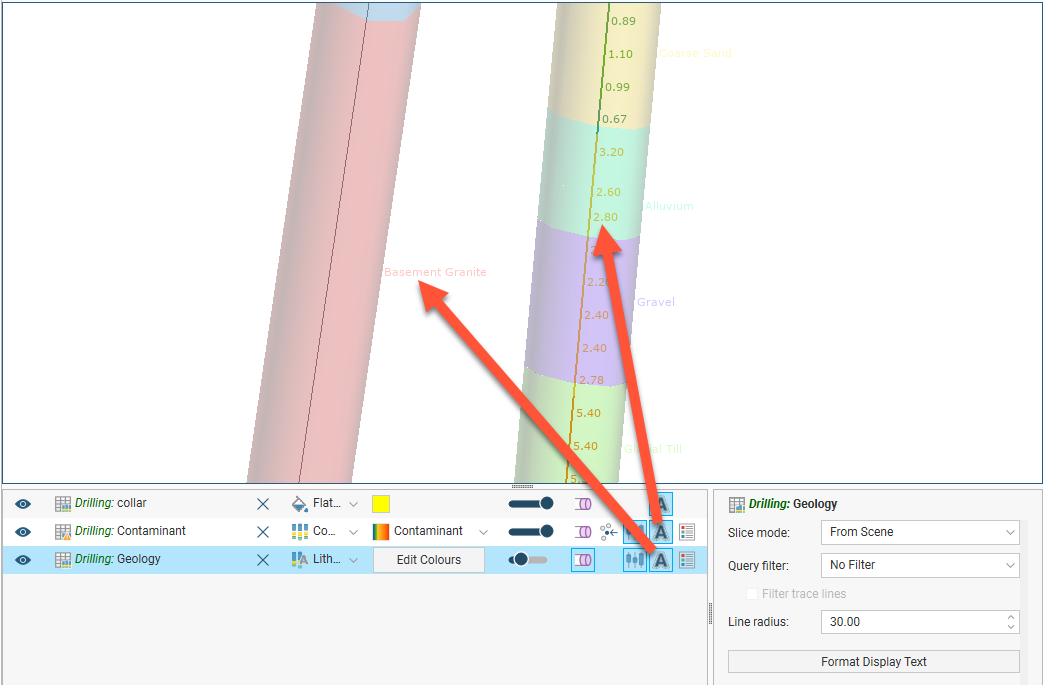
The Show trace lines button (![]() ) in the shape list displays all trace lines, even if there is no data defined for some intervals. The Filter trace lines option in the shape properties panel displays only trace lines for boreholes selected by a query filter. See Using a Filter in Displaying Data in the Filtering Data topic for more information.
) in the shape list displays all trace lines, even if there is no data defined for some intervals. The Filter trace lines option in the shape properties panel displays only trace lines for boreholes selected by a query filter. See Using a Filter in Displaying Data in the Filtering Data topic for more information.
The rest of this topic describes the different ways of displaying drilling data. It is divided into:
- Displaying Boreholes as Lines or Cylinders
- Hiding Lithologies
- Displaying a Legend
- Changing Colourmaps
- Viewing Multiple Interval Tables
- Selecting From Multiple Columns
- Displaying Interval Data in the Scene
- Displaying a Survey Table
- Displaying Borehole Traces
- Displaying Borehole Graphs
Displaying Boreholes as Lines or Cylinders
You can display boreholes as lines or cylinders. You can also display the data associated with each segment. Here, the boreholes are displayed as flat lines:

The width of the lines is set in the shape properties panel.
When the Make lines solid button (![]() ) is enabled, the boreholes are displayed as cylinders and the property that can be controlled is the Line radius:
) is enabled, the boreholes are displayed as cylinders and the property that can be controlled is the Line radius:
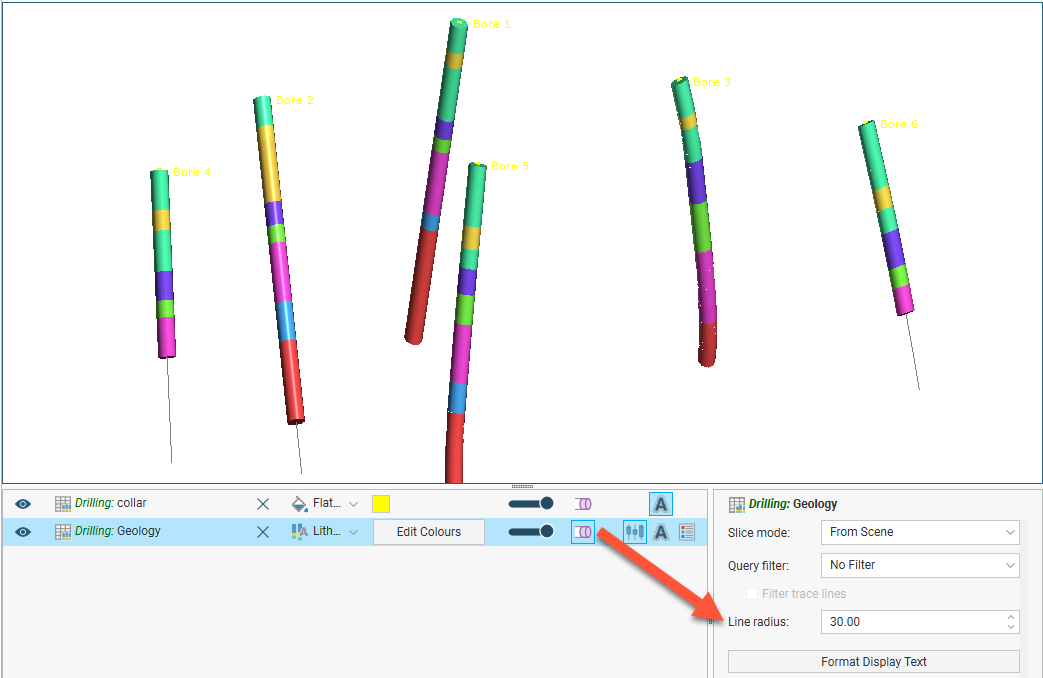
When numeric data is displayed, there is an additional option, to use a data column in the table for the cylinder radius:
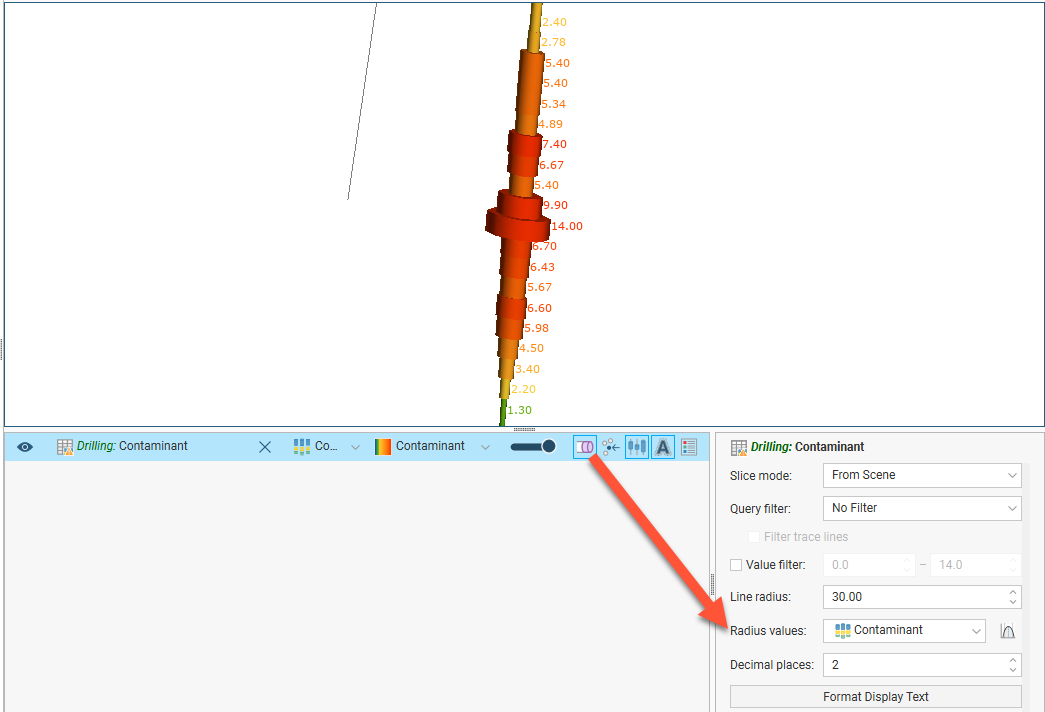
When the log button (![]() ) is enabled, the log of values is used for the radius.
) is enabled, the log of values is used for the radius.
Hiding Lithologies
When lithology tables are displayed, you can hide some of the lithologies to help make better sense of the information in the scene. Click on the Edit Colours button in the shape list. In the window that appears, use the Show/Hide buttons (![]() ) to determine what segments are displayed:
) to determine what segments are displayed:
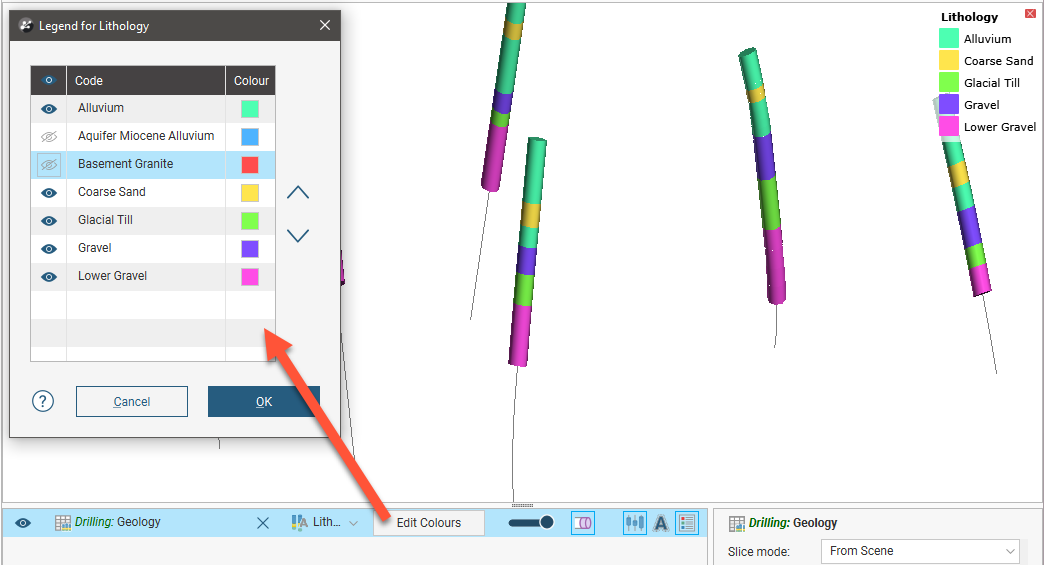
To select multiple lithologies, use the Shift or Ctrl keys while clicking. You can then change the visibility of all selected lithologies by clicking one of the visibility (![]() ) buttons.
) buttons.
Hiding lithologies in this way only changes how the data is displayed in the scene. Another way of limiting the data displayed is to use a query filter (see Using a Filter in Displaying Data in the Filtering Data topic), which can later be used in selecting a subset of data for further processing.
Displaying a Legend
To display a legend in the scene, click the Show legend button (![]() ) for the table:
) for the table:
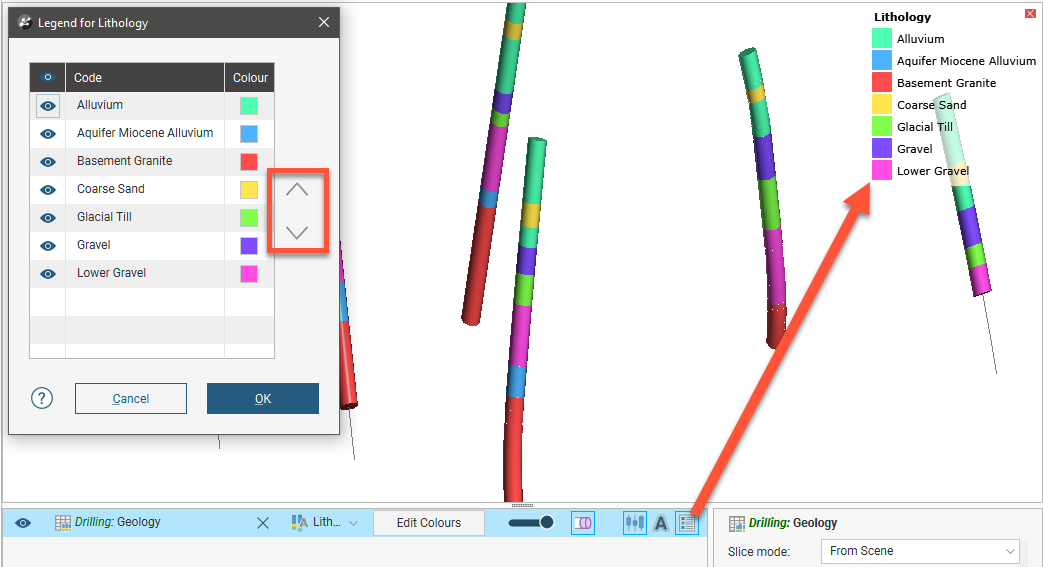
The legend in the scene will be updated to reflect lithologies that are hidden in the scene when you click Edit Colours and hide some lithologies.
To reorder the legend, click the Edit Colours button in the shape list to open the Legend window. Click on an item in the list, then use the arrows to move it up or down. The legend shown in the scene will be updated when you close the Legend window.
Changing Colourmaps
To change the colours used to display lithologies, click on the Edit Colours button in the shape list. In the window that appears, click on the colour chip for each lithology and change it as described in Single Colour Display.
Use the Shift or Ctrl keys to select multiple codes. This is useful for moving multiple codes up and down in the list.
You can also import a colourmap, which is described in Importing a Category Colourmap.
Viewing Multiple Interval Tables
When viewing multiple interval tables, use the line and point size controls and the transparency settings to see all the data at once. For example, here, the geology table has been made transparent to show the contaminant intervals inside:
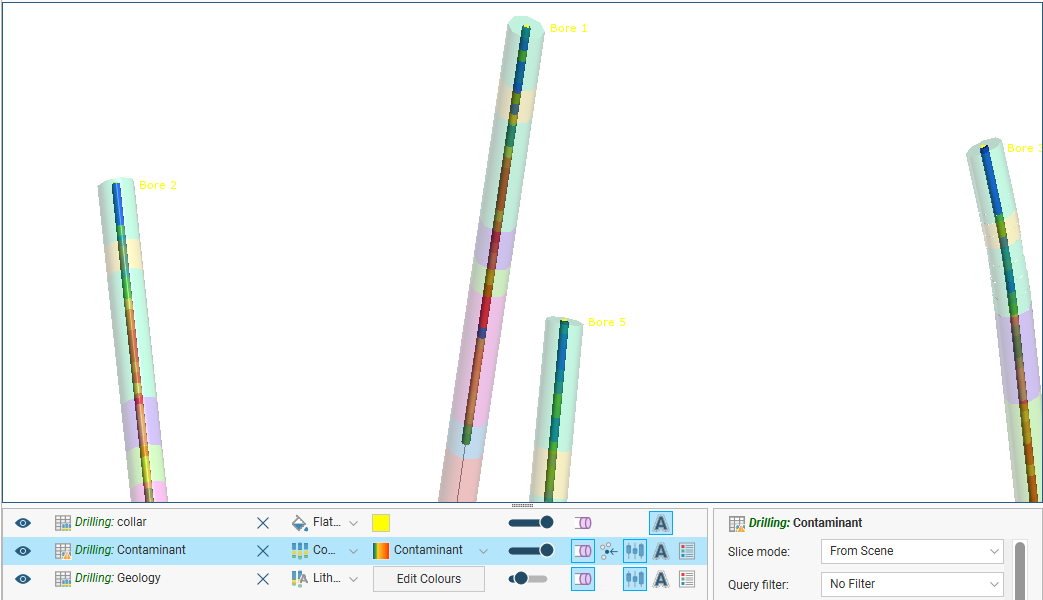
Selecting From Multiple Columns
When an interval table has more than one column of data, select the column to view from the view list:

Some columns are editable, in which case you can click on the Edit button (![]() ) to start editing the table:
) to start editing the table:

Displaying Interval Data in the Scene
Boreholes can be displayed with the data associated with each segment. For example, in the scene below, contaminant values are displayed along the borehole:
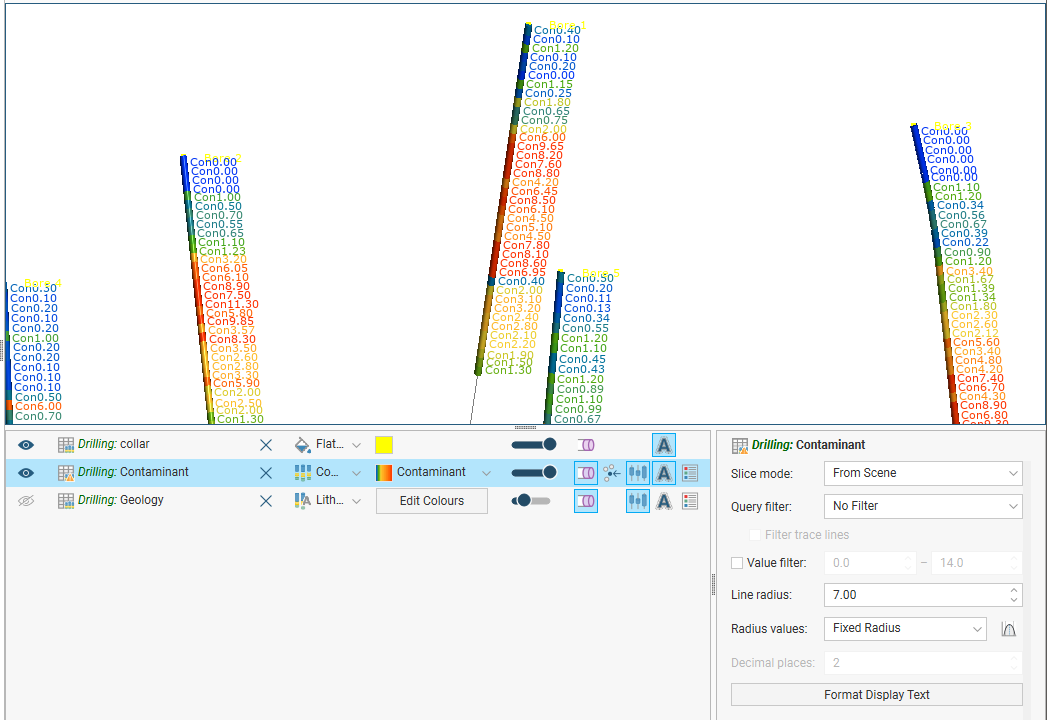
To view data in this way, select the table in the shape list, then click on the Format Display Text button. In the Text Format window, click Insert Column to choose from the columns available:

You can display multiple columns and add text:
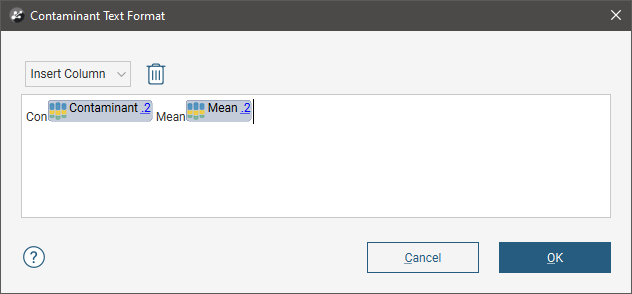
Click OK to update the formatting in the scene. You can conceal the formatting in the scene by clicking on the Show text button (![]() ) in the shape list:
) in the shape list:
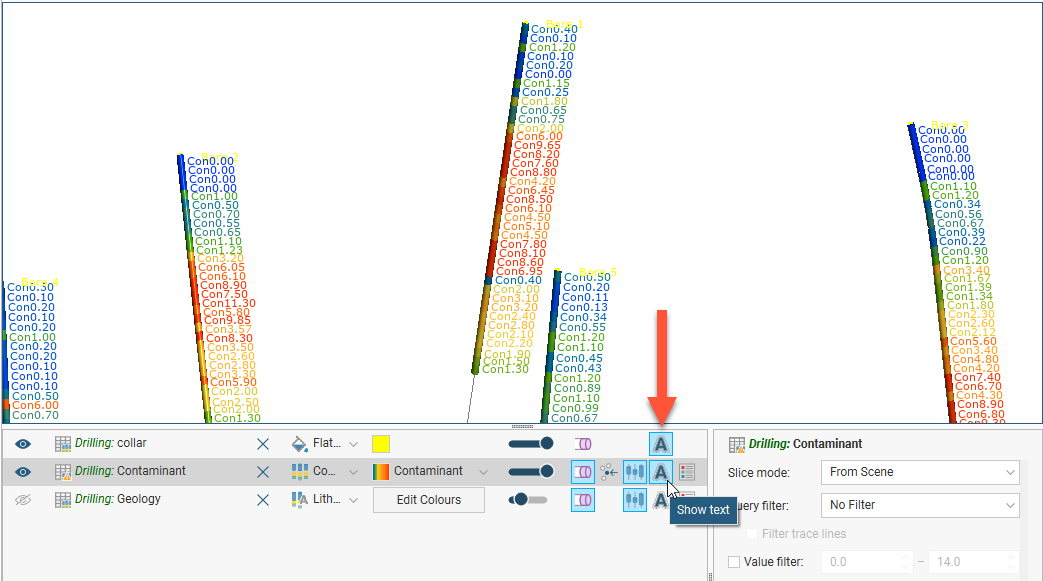
Clear text formatting by clicking on the Format Display Text button, then on the Delete button (![]() ).
).
Displaying a Survey Table
When you add the survey object (![]() ) to the scene, each of the survey point measurements is shown using a tangent cone pointing in the surveyed point's downhole direction. The Show text button (
) to the scene, each of the survey point measurements is shown using a tangent cone pointing in the surveyed point's downhole direction. The Show text button (![]() ) will show or hide the associated value alongside the tangent cone. The cone can be assigned a colour using the view list.
) will show or hide the associated value alongside the tangent cone. The cone can be assigned a colour using the view list.
When the survey object is selected in the shape list, the properties panel will show options to adjust:
- Cone length. The size of the tangent cone.
- Scale values options. These modify the size of the tangent cone using a selected factor or keeping the Fixed Length specified in Cone length. There is also the option to click the Use log of value for radius button (
 ) for value ranges that will benefit from the log scaling.
) for value ranges that will benefit from the log scaling. - Decimal places. This specifies the precision of the label shown in the scene.

Displaying Borehole Traces
Adding the traces object (![]() ) to the scene can be useful in visualising the extent of drilling. You can change the colour used to display the traces, and they can be displayed as lines or cylinders. You can also display depth markers in the scene. To do so, click on the traces in the shape list and enable the Show depth marks option:
) to the scene can be useful in visualising the extent of drilling. You can change the colour used to display the traces, and they can be displayed as lines or cylinders. You can also display depth markers in the scene. To do so, click on the traces in the shape list and enable the Show depth marks option:

Depth markers can be displayed with or without text. Enable the Show text option ((![]() )) to display the depth values. This option also displays the hole ID, which can be displayed at the start or the end of the borehole.
)) to display the depth values. This option also displays the hole ID, which can be displayed at the start or the end of the borehole.
Displaying Borehole Graphs
Downhole numeric data can be displayed in the scene as a bar graph and downhole points data can be displayed as a line graph. To display downhole data in this way, add the graphs object (![]() ) to the scene. The Borehole Graph Style Manager will be displayed, showing the data columns available:
) to the scene. The Borehole Graph Style Manager will be displayed, showing the data columns available:
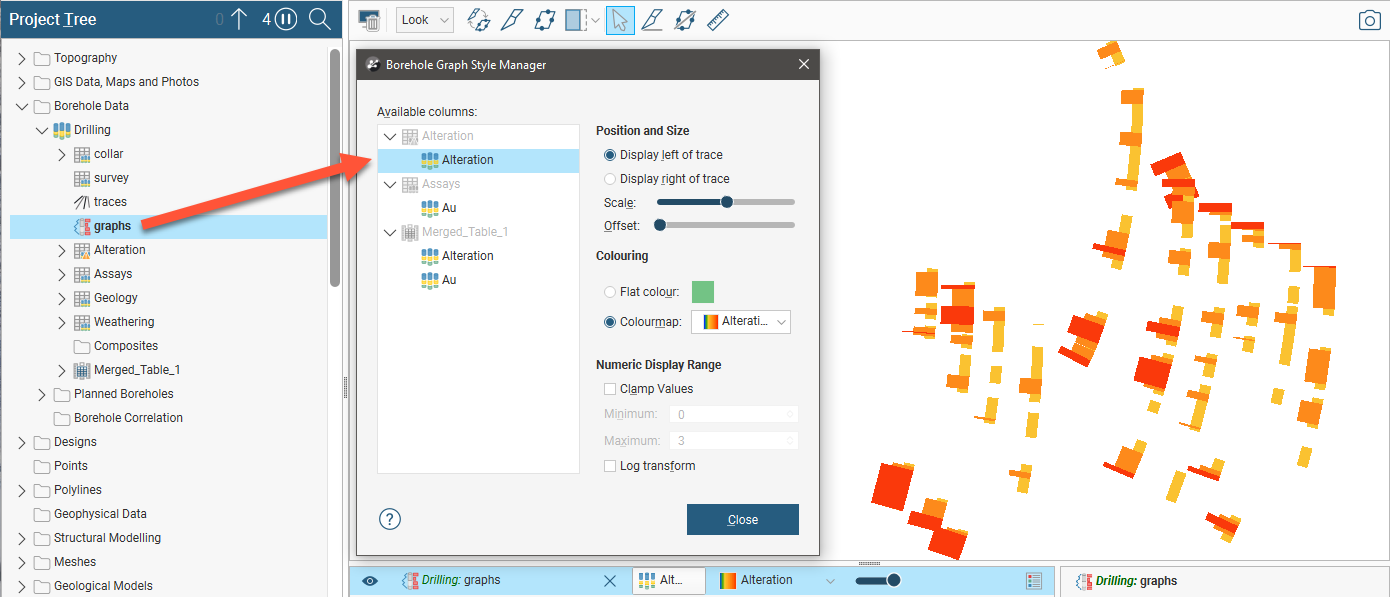
Data can be displayed to the right or the left of the borehole trace. Use the sliders to change the Scale and the Offset from the trace.
Data can be clamped, e.g. all values above the set maximum value will be set to the maximum value.
If there are negative values in the data, they will be displayed on the graph with a value of zero.
Downhole points can be displayed as a line, and you can change the Colouring, Scale and Offset of the line:
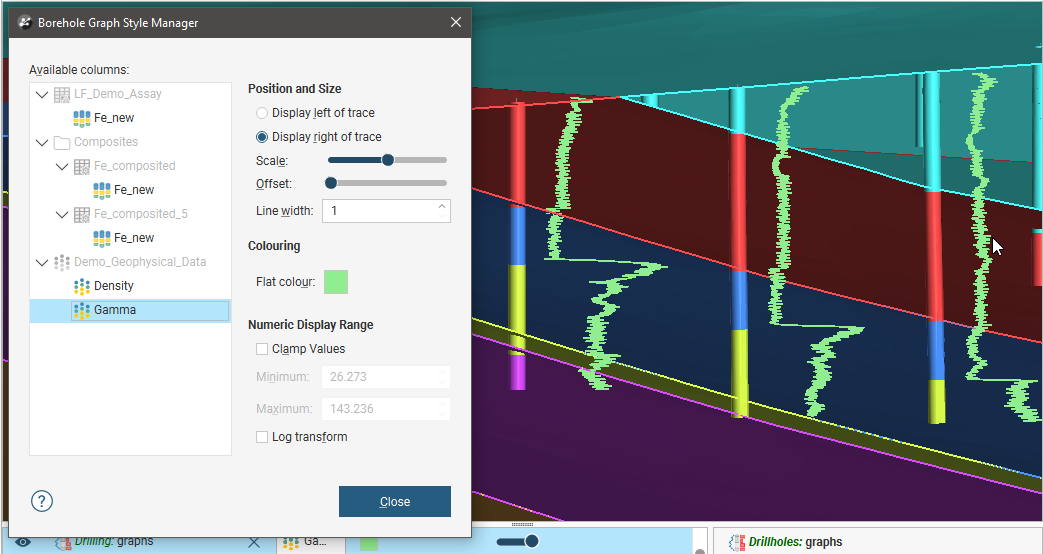
All changes made in the Borehole Graph Style Manager are automatically updated in the scene so you can experiment with the settings. Once you have closed the window, you can also change the Scale and Offset by clicking on the graphs object in the shape list:

To select a different column to display, open the style manager by double-clicking on the graphs object in the project tree or select a new column from the shape list.
If you are working in a new project into which you have just imported boreholes, the Borehole Graph Style Manager will open when you add it to the scene. If the Borehole Graph Style Manager does not open when you add the graphs object to the scene, it is because the styles have already been set, perhaps by another user. You can change them by double-clicking on the graphs object.
